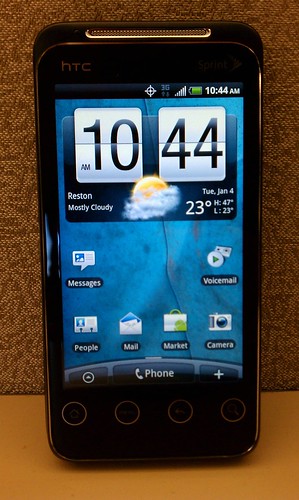I’ve written previously about how to root the HTC Evo Shift. In that post, I identified the Android ROM I ended up using. For the last 9+ months, I’ve been incredibly happy with my EVO Shift without making any significant changes. I guess this is somewhat rare among people who tend to root their Android devices, but I don’t have a lot of time to waste playing with tweaks and mods. Consequently, once I find something nice and stable that performs well, I tend to stick with it.

Recently, however, my Evo Shift has been low on space quite a lot. For the last month or so, I’ve founded myself uninstalling some apps, double-checking some others to make sure they’d been moved to the SD card (another luxury that actually works on a rooted device), and frequently deleting the browser’s cache. These have all been band-aid attempts at freeing up space so that basic functions would work (such as GMail sync).
Finally, I’d had enough. I decided that it would be worth it to revisit the forums around rooting, tweaking, modding and hacking Android devices. Since I’d had such a great experience with the ROM I download last October, I decided to try out TheMikMik.com and see if they’d done anything new. Thankfully, they had!
Checking out this thread, I downloaded the MikShifted-G v2.1 ROM. This ROM features Android 2.3.4 (Gingerbread), HTC Sense, and lots and lots of tweaks and mods.
Something New: Titanium Backup
One thing I did differently this time was that I downloaded Titanium Backup from the Google Play store. After testing it out a little bit, I opted for the paid version because it added some great, worthwhile enhancements. I had already fulled backed up my Evo Shift via Nandroid, which comes with Clockwork Recovery, but I wanted to be able to restore certain data. In particular, my daughter has made lots of progress on the 3 versions of Angry Birds that I keep on my device for her amusement (OK… for mine too), and some other games & apps had data that wouldn’t have otherwise survived the upgrade. Titanium Backup permits the backup and restoration of this kind of data. I specifically used it to back up the data before proceeding with installing my shiny new ROM.
So… here’s what the steps looked like for me this time:
- Download the ROM (.zip file) and copy it to the device’s SD card. I did this from my laptop and transferred it via a USB cable. You could theoretically just downloaded the .zip using the phone, but I was doing all my reading and research from my laptop.
- Perform a full Nandroid backup
- Reboot the device
- Install Titanium Backup, then backup data from specific games/apps
- Reboot to Clockwork Recovery
- Wipe everything several times
- Install the new ROM from the .zip file on the SD card
- Step through the device’s configuration process
- Reinstall apps and selectively restore data using Titanium Backup
I made a list of all the apps that I wanted to be sure to re-install. This turned out to be unnecessary because Google has greatly improved the user experience in the Play store. They’ve always permitted users to re-download purchased apps, but I found this time that even the free apps (some of my favorites are free ones) were readily accessible.
Another luxury for me this time around involved easily restoring my SMS messages. Unfortunately it didn’t occur to me to back these up separately before wiping my device, so after re-installing all my apps, I decided to see if there was an easy way to pull these out of my Nandroid backup. It turns out that Titanium Backup has a very simple procedure for restoring this data too. It’s just like restoring data from apps… the only trick is knowing which data to restore. It turns out that SMS messages are stored with the “Dialer History” (at least that’s the case with these HTC ROMs). After the restore and a simple reboot, all my SMS messages came right back. Thank you, Titanium Backup!
This whole process took a couple of hours of my time, some of which was spent on the minutiae of sorting out what data from which apps I wanted to backup. I also am a bit meticulous about configuration. Now that it’s all finished, I’m back to virtually the identical set of apps as before, but I have tons of free space and my device is running faster and more smoothly than ever!
I’m a very happy camper. Thanks very much to aamikam and all the others at TheMikMik and XDA Developers who work so hard at making such fantastic tools available to us!


